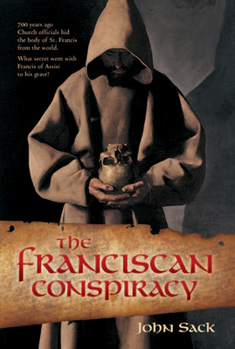The Franciscan Conspiracy
Select Format
Select Condition 
Book Overview
A coded letter drives the devout monk Conrad into the bawdy, treacherous society of 13th-century Italy. His quest to discover the truth behind St. Francis' death entangles Conrad in the lives of... This description may be from another edition of this product.
Format:Hardcover
Language:English
ISBN:1883991919
ISBN13:9781883991913
Release Date:May 2005
Publisher:Riverwood Books
Length:244 Pages
Weight:1.55 lbs.
Dimensions:1.1" x 6.2" x 9.3"
Customer Reviews
4 ratings
The Franciscan Conspiracy
Published by Thriftbooks.com User , 17 years ago
If you like intriguing fiction novels, then this book is for you. Based on some facts concerning the mystical Franciscan Order, and a little imagination of the author (similar to the Da Vinci Code) this is an interesting book. The best character of the book is sister Amata (Amatina), a pernicious young girl. I hope they will make a movie based on this book.
Fascinating Conclusion!
Published by Thriftbooks.com User , 18 years ago
I see one reviewer is very upset at Sack's suggestion that Francis had leprosy. Actually, the article "The Diagnosis of St. Francis: Evidence for Leprosy" (Franciscan Studies 47 (1987), pp. 181-217), which is edited by St. Bonaventure University, supports the probability that Francis had leprosy. These scholars would be the last people to disrespect Francis. Nor does Sack; he obviously admires the Saint. A great historical novel, but even its "fiction" is plausible.
Fantastic!
Published by Thriftbooks.com User , 19 years ago
This is a great read and really stretches the reader's mind and imagination! The prose is absolutely lyrical! I'm also enjoying the debate over the authenticity of Sack's research. I went to the website for the book and found the author's bibliography. If he read all these sources, I'd have to say his research is downright impressive. Two thumbs up!
Reviewers need to do their homework
Published by Thriftbooks.com User , 19 years ago
Although this work is fiction, I found it totally plausible. An earlier reviewer says St. Francis' body was never kidnapped and hidden. Actually, there are two historical accounts of the event. John Sack seems to have chosen the more dramatic version. (In the other account, the body was simply removed during the night). Also, although the earlier legends do exist still, it is only because they were hidden by St. Clare and other orders (such as the Cistercians) not bound by the Franciscan edict to destroy them. Sack includes the original edict on p. 125 of his novel. I would also suggest the reviewer look at pp. 210-11 of the St. Francis "Omnibus of Sources" since she seems to have a copy of that work. [...] This is the most stunning, and best-written novel I've read this year, even better than "Name of the Rose" or "DaVinci Code."





